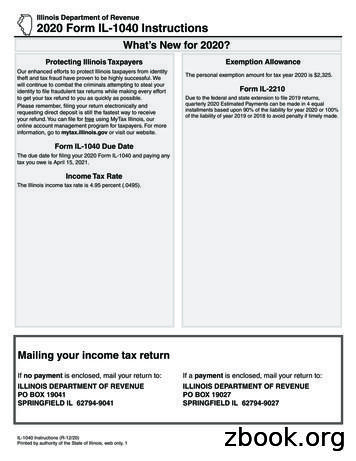Intoduction To Filing Systems
Introduction to Filing SystemsReference: Texas State Library and Archives CommissionALPHABETICAlphabetic systems are the most natural and common method of arranging files.However, even the simplest alphabetic system requires establishing, filingstandards, including written filing procedures, cross-reference methods, andpractices for filing duplicate name changes, etc. Be sure that these filing ruleshave been distributed to staff and ensure that they are consistently beingadhered to. Consider using an alphabetic system for correspondence, smallvolumes of case files, or personnel files.Advantages: One advantage to using an alphabetic filing system is it allows thegrouping of records pertaining to the same individual or company to be filed inone location. Alphabetic filing uses a direct filing system where an additionalreference sheet or an index is not required.Limitations: A limitation of alphabetical filing is misfiled records are hard todetect. Therefore, firm rules need to be set in place as well as cross-references tohelp locate a record that could be filed in multiple locations. Also, it might becommon that duplicate files are accidently created if the original file cannotimmediately be found.Alphabetizing Tips1. Treat acronyms, abbreviations, and radio or TV call letters as one unitExample: File “CIA” after “Central”2. Numbers before alpha charactersExample: File “401K” before “Abbott”3. Disregard punctuation: Treat hyphenated last names or words as one longwordExample: File “Smith-Jones” under “S”4. Treat surnames with prefixes as one long last nameExample: File “de la Hoya” under “D”5. File “nothing” before “something”Example: File “NBA” before “NBAC”
NUMERICAlthough numeric systems are indirect systems (an index is required), theyfrequently are the fastest to use and produce fewer errors. Numbers are lesslikely to be misfiled than letters and misfiles are easier to detect. Oncedeveloped, this is the easiest type of filing system to use and lends itself very wellto color-coding. Unless otherwise specified, numbers are filed consecutively.What exactly is a file index? File indexes explain the numeric system’s file code,which allows the user to decipher where the records are located.Advantages: Accuracy, unlimited expansion, and the opportunity for unlimitedcross-referencing are among the advantages for numeric filing. Since numberscan be used to identify the name or subject when calling for correspondence,there is an element of confidentiality when using a numeric system.Limitations: Numeric filing takes time to code if numbers are not already anintegral part of the document. Transposition of numbers, inaccuracy in copying,and omission of a digit are frequent errors that may not be readily detected.Verification may need to be part of the process. When numbers are assigned byan automated system, a number may be changed or an inactive number may bedropped. This may cause problems in retrieving non-current records.ALPHANUMERICAlphanumeric filing may use a combination of personal or business names, andnumbers, or more commonly, subject names and numbers. Once the alphabeticdivisions or topic headings and appropriate subdivisions have been determined,number categories can be assigned, if large quantities or records are to be storedwithin the system, smaller divisions within each letter of the alphabet can beused. A relative index lists the number codes assigned to each letter of thealphabet or to its divisions. The file worker refers to the index to determine theprimary filing digit to be assigned to a file for a new correspondent or document.Advantages: Alphanumeric systems are very flexible and are appropriate for verylarge filing systems.
GEOGRAPHICGenerally, avoid the use of geographic filing systems unless location is the primaryfunction or feature of the record series. Traffic signal or tax appraisal recordsmight be appropriately filed by location, but probably not filing taxpayer recordsby location. Geographic systems may use alphabetic filing features (file names) orthey may be coded numeric or alphanumeric.Limitations: This filing system should only be used when location is a primaryfunction.TERMINAL-DIGIT SYSTEMThis system first considers the segment on the right, then the middle segment,and finally the segment on the left.1st 31 – 99 – (12)2nd 31 – (99) – 123rd (31) – 99 – 12This system is best used again for large, active paper-based filing systems whenrecords are numbered sequentially upon creation.Advantages: Terminal digit systems have the advantage of distributingsequentially created records throughout the filing system, rather than placingthem physically together. This reduces the need to frequently shift all the recordsas older records are destroyed and new records are created.
EXAMPLESAlphabetical Filing #1CD’s are filed alphabetically by group name or last name.Elvis Presley is filed under P because it is the first letter in the last name.Pink Floyd is filed under P because it is the first letter in the group name.Bob Dylan is filed under D because it is the first letter in the last name of a realperson.How do you file Jethro Tull?It is filed under J because Jethro Tull is the name of a band, not a person, and istherefore filed under the first name of the group name. This exhibits howalphabetic filing systems can potentially cause problems or confusion. Ifsearching for Jethro Tull, but were not aware that this was not the name of aperson, then you might look under T for Tull instead of J for Jethro. A crossreference would be a helpful tool in an instance like this.Alphabetical Filing #2Alphabetize by unit (most important unit filed first)Stephen F. Austin(broken down into 3 units: Unit 1: Stephen, Unit 2: F, Unit 3: Austin)When referring to Stephen F. Austin the person, the most important unit is thelast name Austin (Unit 3), and should be filed under A for Austin, Stephen F.When referring to Stephen F. Austin the University, the most important unit is thefirst name Stephen (Unit 1), and should be filed under S for Stephen F. AustinUniversity.
Numeric Filing Example101-16-009To read this system, an index is needed.The first number in the series, 101, is the code for this file’s county. At thisagency, all 254 counties are assigned numbers ranging from 001 to 254 andcorrespond alphabetically to all the counties in Texas. 001: Anderson County002: Andrews County003: Angelina County004: Aransas County and so on, to county 254 (Zavala County)The second number listed in the file series, 16, is this file’s government type.There are many types of government – cities, school districts, elected countyofficials, and so forth. The codes for government types span from 01-99. Becausethis is a flexible system, only codes 01-34 and 97-99 have been assigned. Whenfuture types of government arise (such as the establishment of appraisal districtsin 1981 by the Texas Legislature), there will be plenty of two-digit codes availablefor these government types. 01: County02: County Judge03: County Commissioners04: County Clerk05: District ClerkThe third portion of the 3-part code, 009, indicates the order of receipt. Forexample, all school districts in Aransas County will be assigned a file codebeginning with “001-18-001”. The first school district that filed paperwork withthe State Library was assigned the file code 001-18-001. The second district to filepaperwork was assigned the file code 001-18-002, and so on up to 001-18-007.In the example above, 101 is the County Code for Harris County. 16 is theGovernment Type Code for a municipality. The municipality was the 9th HarrisCounty municipality to file compliance paperwork with the State Library.101-16-009 Harris County (101), Municipality (16), 9th schedule received (009)
Alphanumerical Filing ExampleIn Library of Congress Classification, all recorded materials – books, CDs, mapsarchival materials, and so forth – must be assigned a unique number. Due to theextraordinary volume of recorded materials in the world, the classificationsystems is alphanumeric.How would the book below be classified by a library cataloger?
Field Guide to Fishing Knots (Darren Brown, 2003)Library of Congress Classification begins with a letter code. Letter codes correspond tosubject areas – these subject areas are the “main classes.” Some main class codes are: B: Philosophy, Psychology, ReligionK: LawM: MedicineP: Language and LiteratureS: AgricultureA book about fishing will fall under the main class “Agriculture.”Within the main class codes, subclasses are assigned. Here are the categories in theAgriculture subclass: Subclass S: Agriculture (general)Subclass SB: Plant cultureSubclass SD: ForestrySubclass SF: Animal cultureSubclass SH: Aquaculture, fisheries, and anglingSubclass SK: Hunting sportsA book about fishing (also called “angling”) would fall under Subclass SH: Aquaculture,fisheries, and angling.After the Subclass has been assigned, the cataloger refers to an even more detailed listof sub-topics. In the “SH” subclass, these sub-topics include: SH 20.3-191: AquacultureSH 201-399: FisheriesSH 400-408: Seafood gatheringSH 401-691: AnglingThe cataloger will use a number in the Angling category: SH 401-691.Finally, the description is further clarified through yet another alphanumeric system,with codes called “cutters.” K6 is the cutter for “knots” (remember that the book isabout fishing knots). The author’s last name is also assigned a cutter – B76 is the cutterfor Darren Brown (the first consonant, B, is used, followed by 7 (r), then 6 (m-o)).The book is ultimately classified with the alphanumeric code SH452.9.K6 B76 2003,which translates to: “a work pertaining to angling knots, published in 2003, by an authorwhose name begins with Brm, Brn, or Bro.”
ALPHABETIC Alphabetic systems are the most natural and common method of arranging files. However, even the simplest alphabetic system requires establishing, filing standards, including written filing procedures, cross-reference methods, and practices for filing duplicate name changes, etc. Be sure that these filing rules
Medical Malpractice Liability Rate/Rule Contact Person: Keith Fanning (217) 782-1792 Line(s) of Insurance/Business: . filing code 11.0030 Dentists – General Practice; filing code 11.0006 Dentists – Oral Surgeon; filing code 11.0007 . filing code 11.0015 Nursing Homes; filing code 11.0016 Occupational Therapy; filing code .
EDGAR Filer Manual (Volume II) 4 March 2022 File Naming Standards, 5-1 Filer-Constructed XML Technical Specifications, 9-1 Filer-Contructed XML Submissions, 9-1 Filing Checklist, 2-3 Filing Date of Electronically Transmitted Submissions, 10 -1 Filing Fee Information, 4-1 Filing Fee, How to Calculate, 4-4 Filing Fees, Filing that Require, 4-3
Candidate Filing: Campaign Contact Information") Pay filing fee by credit card if filing online Pay filing fee by cash or check if filing in person or by mail made out to: Elections Reserve Fund . If a candidate needs to file a petition in lieu of the filing fee because they lack sufficient assets or income, contact our office.
to file electronically, you may use the paper Form IL-1040. Your Illinois filing period is the same as your federal filing period. We will assume that you are filing your Form IL-1040 for calendar year 2020 unless you are filing for a fiscal year and indicate a different filing period in the space provided at the top of the return.
The prime contractor updates the final contract amount during the NOC filing process. Changes in the final contract amount may increase or decrease the filing fees due. When the prime contractor files the NOC in the LSS - Online Filing Services, they must pay any additional filing fee using "Pay Filing Fees Electronically." Contractors who
Delaware E-filing is Corporation Service Company's web-based application designed to make filing your Delaware Corporation, Limited Partnership, Limited Liability and General Partnership taxes faster and easier, whether you are filing for one entity or a hundred. Delaware E-filing features include the following:
principal systems: alphabetic filing, subject filing, and numeric filing. In addition, it contains standard rules for indexing alphabetic data. Used correctly, this standard will establish a uniform files classification system that makes sense to the users while identifying and preserving a set order of records. Three informative appendices .
American Gear Manufacturers Association 500 Montgomery Street, Suite 350 Alexandria, VA 22314--1560 Phone: (703) 684--0211 FAX: (703) 684--0242 E--Mail: tech@agma.org website: www.agma.org Leading the Gear Industry Since 1916. May 2004 iii Publications Catalog How to Purchase Documents Unless otherwise indicated, all current AGMA Standards, Information Sheets and papers presented at Fall .























